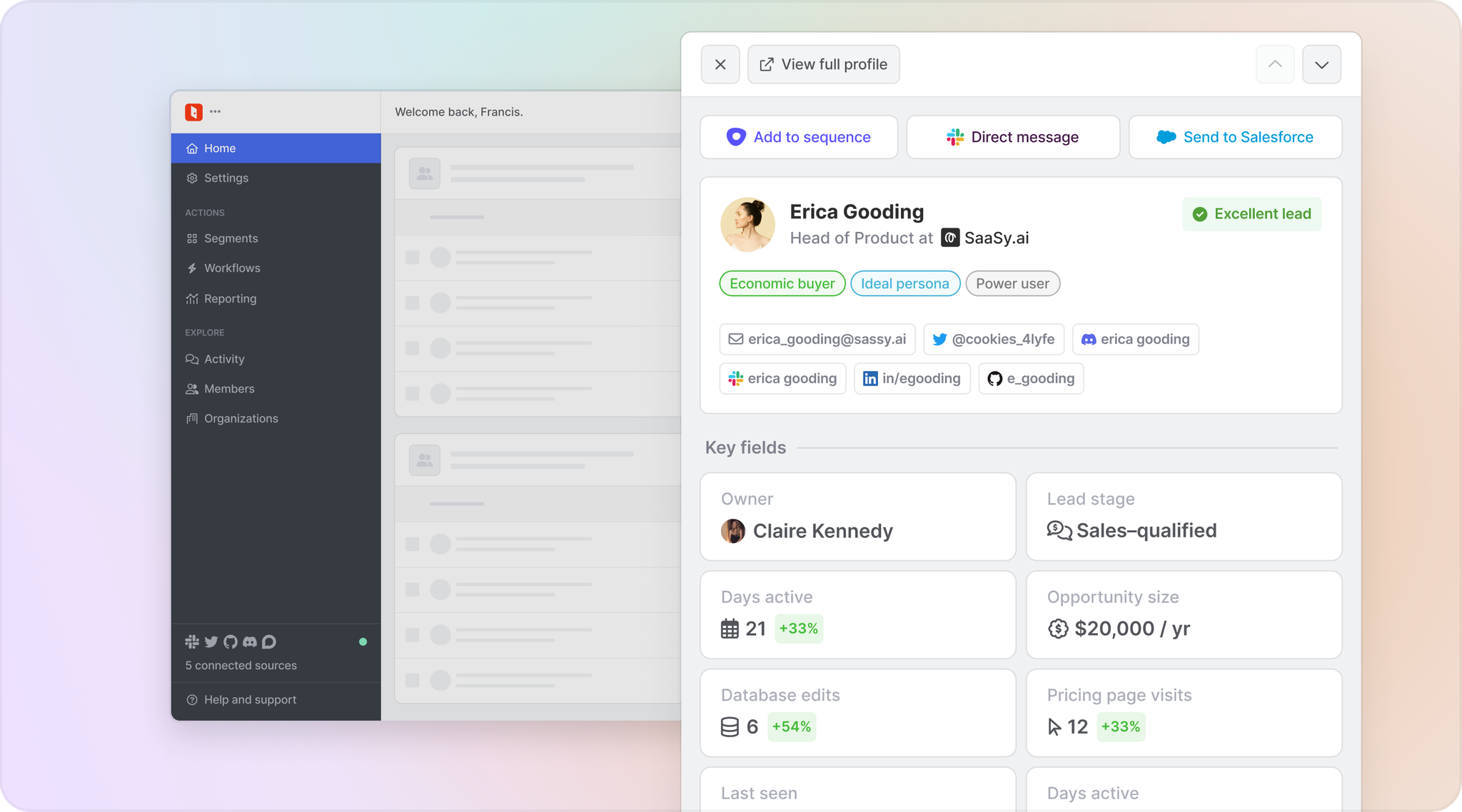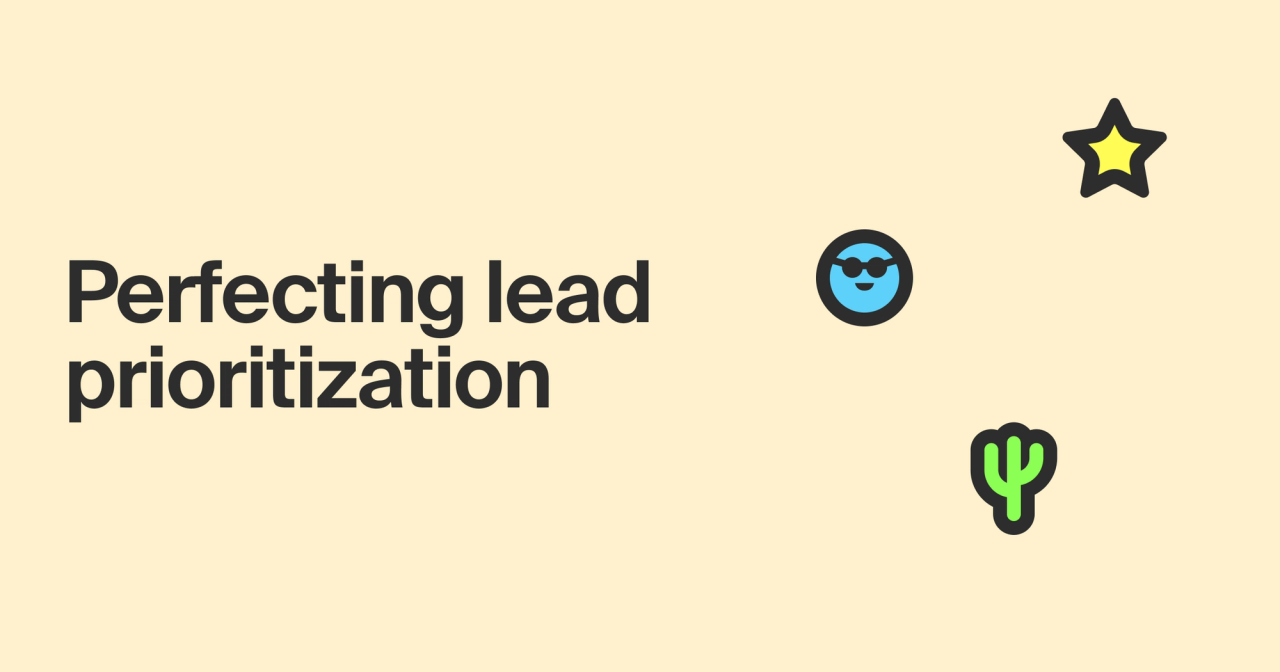If lead generation is what fuels your revenue engine, lead prioritization is the GPS that points you toward closed-won deals.
It’s not exactly a state secret: Qualified leads who are actually interested in buying from you are better for your bottom line.
But knowing how to prioritize leads—quickly and at scale—isn’t always easy.
Sales teams often spend too much time hunting for the needle in the haystack (killing sales efficiency in the process). Or they simply settle for a rush job that leaves reps chasing the wrong opportunities (defeating the entire point of lead prioritization in the first place).
There’s a better way.
Keep reading to learn:
- Why intent and fit are both essential to lead prioritization
- What’s standing in the way of your prioritization process
- How to zero in on the best leads faster
Lead prioritization is where intent and fit meet
Some sales leads are worth your time. Others aren’t. Lead prioritization is the process of figuring out which is which.
Imagine your company launches a new product feature. It makes a big splash on social media and your fancy explainer video starts racking up views. Cue the free trial sign-ups and demo requests.
Sounds great, right? But there’s only so much time in a day.
Every hour spent talking to someone who’s not ready to buy or not the right fit for your product is an hour that could have been spent converting a high-quality lead.
Buyer intent—the signals that indicate someone is interested in doing business with you—is important. But it’s only one piece of the prioritization puzzle.
Buyer fit—the signals that show you whether an opportunity is worth pursuing in the first place—is just as crucial.
Unfortunately, balancing “they want us” with “we want them” is trickier than it should be.
So sales teams waste time on tire kickers. Quotas are missed. And high-propensity buyers get lost in the shuffle.
Recognize the wrench in your prioritization process
Sales reps aren’t stupid. They know that prioritizing leads is important.
But doing it fast and effectively is easier said than done.
On average, reps only spend 28% of their week actively selling. That’s because they’re bogged down researching leads and figuring out which ones should be at the top of their to-do lists.
Companies invest in tools and tactics that are supposed to make lead prioritization easier, but they leave a lot to be desired.
Your average marketing-qualified lead is too often based on vanity metrics (an eBook download doesn’t automatically translate to “hot lead”). So reps waste time on discovery calls with uninterested and unqualified buyers instead of creating sales-qualified leads.
Then there’s the status quo of lead scoring. The idea is that someone from the marketing team (or the data science team, if you’re really lucky) will use a predictive model to take the guesswork out of prioritization, freeing up reps to focus on the best opportunities.
But sales reps are generally locked out of this process. They don’t have any visibility into which attributes and actions power scoring models. They’re just expected to work off of vague numerical scores that are devoid of any context (and likely missing key inputs).
What reps really need is easy access to buyer identity, intent, and context:
Identity
Business email domains (or, worse yet, personal Gmail addresses) aren’t enough.
Reps need to know exactly who they’re talking to, what they do, where they work, and other firmographic details.
Otherwise reps waste time piecing together their view of the buyer (or never do it at all).
Intent
Outdated behavioral data that stops at the account level isn’t enough.
Reps need to know exactly what people are saying and doing, everywhere they’re saying and doing it. They also need to see the people behind the activity to make sure they’re the right fit.
Otherwise reps organize their outreach around stale, ambiguous clues.
Context
Siloed data points aren’t enough.
Reps need to know exactly what’s driving buyer activity in the first place, when and where it’s happening, and how these signals should inform messaging and timing.
Otherwise reps end up sifting through disjointed data sources or, more likely, make do with an incomplete picture of the buyer.
Getting access to this information isn’t necessarily the problem—getting access to it quickly and scalably is.
Sales teams now use an average of 10 separate tools to close a deal.
With buyer insights chained to multiple data sources and technologies, lead prioritization turns into a tedious and time-consuming process.
How Common Room helps you speed up lead prioritization
Common Room is designed to help sales teams uncover and qualify leads fast.
Here’s how:
Paint the full buyer picture
Common Room’s AI-powered identity resolution engine automatically centralizes, deanonymizes, and enriches leads based on all available digital interaction, product usage, and customer relationship data.
In other words, sales teams get served comprehensive buyer profiles—names, job histories, cross-channel activities, contact information, and more—on a silver platter.
🎤 "Common Room has made it easier for our SDRs and AEs to book more and better meetings. It’s our favorite sales tool here. One of our AEs called it 'my closest friend.'"
—Tyler Hayden, Director of Sales Development at Pulumi

See every signal
Common Room surfaces all traceable activities across connected data sources—including dark-funnel channels that were previously hidden from view—to help reps dive deep into cross- channel actions, conversations, and more.
These signals can then be used to create actionable, contextual lead and account scores that tell reps exactly why someone is worth reaching out to.
🎤 "Common Room gives our go-to-market team members daily feeds of users showing intent across multiple channels—all in one place. Over 50% of our meetings come from Common Room."
—Tim Hughes, Vice President of Sales at Temporal

Qualify with a click
Common Room provides user-friendly filters and tags that allow reps to zero in on high-fit leads based on any dimension—from role and organization size to economic buying power and tech stack configuration.
Meanwhile, intelligent automations make it easy to segment leads based on granular attributes and actions, stay alerted to their activities in real time, and engage them via email, Slack, social media, and more—all from the same location.
🎤 "Common Room made the operationalization process easy and within a few days we were off to the races. Our sales team has realized real results with meetings booked."
—Aisha Nins, Senior Sales Operations Program Manager at Apollo GraphQL

Lead prioritization doesn’t have to be hard.
The first step is making sure sales teams have the tools they need to quickly separate the best opportunities from the rest.
Accelerate lead prioritization with Common Room
Ready to see how Common Room helps you hone in on the best leads faster?

